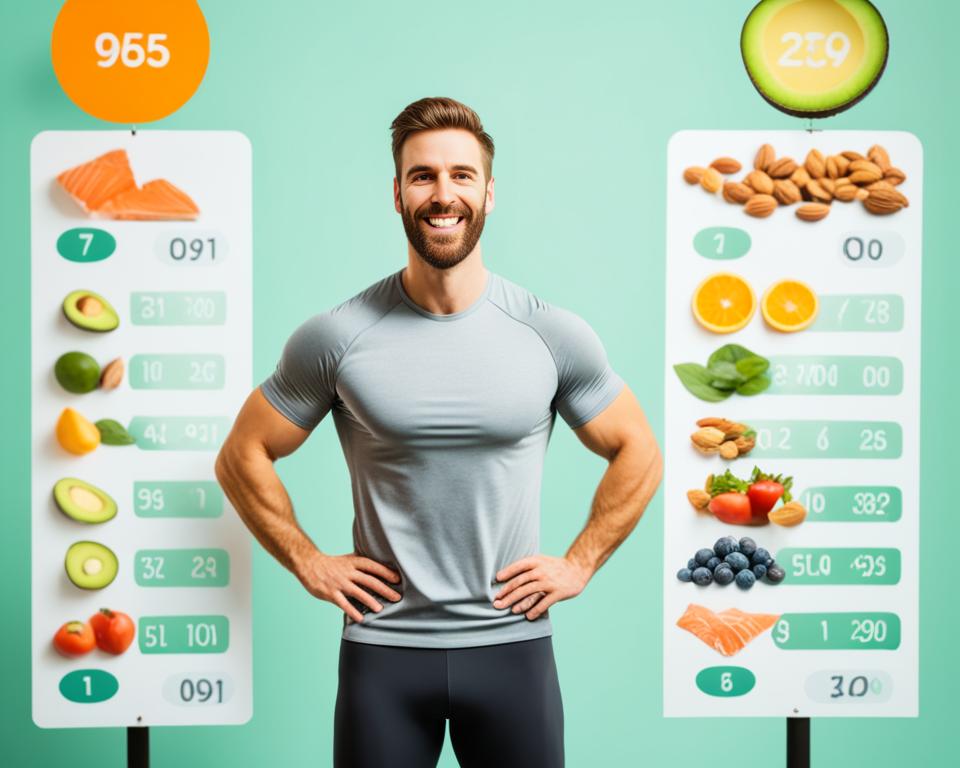Starting a ketogenic diet can change your health, help you lose weight, and boost your energy. This guide will give you the knowledge and tools to start and keep a keto lifestyle. It’s perfect for both newbies and those who love the keto diet. You’ll learn the basics, get tips for starting, and how to handle common challenges.
Key Takeaways
- Understand the principles of the ketogenic diet and how it works to promote fat loss
- Learn the benefits of following a keto diet, such as improved blood sugar control and increased energy
- Discover strategies for transitioning to a keto-friendly way of eating and meal planning
- Explore keto-friendly recipes and snacks to make your journey delicious and satisfying
- Gain insights on tracking your progress and overcoming the keto flu during the initial transition
What is the Keto Diet?
The ketogenic, or “keto,” diet is a low-carb, high-fat eating plan. It has become very popular in recent years. This diet helps your body enter a state called ketosis. In this state, your body gets good at burning fat for energy instead of carbs.
Understanding Ketosis
When you cut down on carbs, your body looks for another fuel source. This is where ketosis comes in. In ketosis, your liver turns fat into molecules called ketones. These ketones can be used by your body and brain for energy.
Benefits of Following a Keto Diet
The keto diet has many health benefits, including:
- Weight loss: The keto diet can lead to significant weight loss for many people by switching to fat-burning mode.
- Improved insulin sensitivity: Eating fewer carbs can help improve insulin function and lower the risk of type 2 diabetes.
- Reduced inflammation: The high-fat, low-carb keto diet may help reduce inflammation in the body.
- Increased energy and mental focus: Ketones provide a stable, consistent source of energy for the brain and body.

Remember, the keto diet might not work for everyone. Always talk to a healthcare professional before making big changes to your diet.
Getting Started with Keto
Starting a keto diet can feel both thrilling and overwhelming. It’s important to prepare well for your journey. We’ll help you with the essential steps to begin the keto diet smoothly.
The first step is to set your macronutrient goals. The keto diet needs a certain balance of fats, proteins, and carbs to enter ketosis. Talk to a healthcare expert or use online tools to find the right amounts for you.
Then, gather keto-friendly foods. Stock up on healthy fats, low-carb veggies, quality proteins, and other key items for your keto diet plan. Meal planning can help you stay on track and resist bad choices.
For keto diet meal prep, focus on making easy, nutritious meals for the week. Try different recipes and pick the ones you like best. This makes sticking to the keto diet easier over time.

Preparing your keto diet for success sets you up for great results. Remember, being consistent and patient is crucial as your body adjusts. With the right mindset and prep, you’re ready for a rewarding keto diet journey.
Keto Diet Meal Planning
Starting a keto diet means knowing which foods to eat and avoid. By using a keto food list and adding keto-friendly recipes to your keto meal prep, you keep your body in fat-burning ketosis.
Keto-Friendly Foods
A keto diet is built on healthy fats, low-carb veggies, and high-quality proteins. Great keto foods include:
- Avocados
- Nuts and seeds
- Olive oil and coconut oil
- Leafy greens like spinach, kale, and arugula
- Berries in moderation
- Meat, poultry, and seafood
- Eggs
- Full-fat dairy products
Foods to Avoid on Keto
To stay in ketosis, cut down on high-carb foods. Avoid or eat less of these on a keto diet:
- Grains and starches (bread, pasta, rice, potatoes)
- Sugary foods and beverages (soda, candy, juice)
- Legumes (beans, lentils, chickpeas)
- Most fruits (except for berries)
- Root vegetables (carrots, parsnips, turnips)
Stick to a balanced keto food list, use keto diet recipes, and plan your keto meal prep. This will help you reach your health and weight loss goals on the keto diet.

Starting a Keto Diet Guide
Starting a keto diet is exciting and can change your life. If you want to lose weight or try the ketogenic lifestyle, this guide will help you start right.
First, set clear goals for your keto diet. Do you want to lose weight, boost your energy, or manage a health condition? Knowing your goals will keep you motivated and help you track your progress.
When starting your keto diet, watch out for the “keto flu.” This phase may make you feel tired, irritable, and have headaches. But don’t worry, staying hydrated and taking electrolyte supplements can help you get through it. With patience, you’ll enjoy the benefits of ketosis.
- Establish your macronutrient ratios: Aim for a ratio of approximately 70% fat, 20% protein, and 10% carbohydrates.
- Prioritize keto-friendly foods: Focus on healthy fats, low-carb vegetables, and moderate amounts of protein.
- Stay hydrated and replenish electrolytes: Drink plenty of water and consider supplementing with sodium, potassium, and magnesium.
- Track your progress: Monitor your weight, body measurements, and energy levels to celebrate your successes and make any necessary adjustments.
Starting a keto diet is a journey, not just a goal. Enjoy the process, listen to your body, and appreciate the benefits of the ketogenic lifestyle.

Keto Diet Recipes
Following a keto diet means eating tasty meals that meet your nutritional needs. This section offers keto-friendly recipe ideas for breakfast, lunch, and dinner. These recipes make meal prep easy and help you stick to your new diet.
Breakfast Ideas
Starting your day with a low-carb and high-protein breakfast is key to staying in ketosis. Here are some delicious keto diet recipes to try:
- Scrambled eggs with avocado and bacon
- Keto-friendly yogurt parfait with berries and nuts
- Cauliflower hash browns with sausage and cheese
Lunch and Dinner Options
For midday and evening meals, choose low-carb options that are filling and tasty. Consider these great keto diet recipes:
- Grilled salmon with roasted asparagus and lemon butter
- Zucchini noodles with creamy chicken Alfredo
- Beef and broccoli stir-fry with cauliflower rice

By adding these keto-friendly recipes to your meal plan, you’re on your way to mastering the keto diet. You’ll enjoy delicious, healthy meals all day.
Monitoring Your Progress
Tracking your progress is key when you’re on the keto diet for weight loss and health benefits. Keeping an eye on your progress helps you see if the diet is working for you. This way, you can make changes if needed to reach your goals.
Tracking Macronutrients
The keto diet focuses on the right balance of fat, protein, and carbs. By tracking your macros, you can stay in ketosis and get the most out of the keto diet benefits. Here are some tips for tracking your macronutrients well:
- Use a food tracking app or journal to record your daily food intake and monitor your macronutrient ratios.
- Aim for a macronutrient ratio of approximately 70% fat, 20% protein, and 10% carbs.
- Adjust your macros as needed based on your individual goals and response to the diet.
- Pay close attention to your carb intake, as staying below your personal carb threshold is crucial for remaining in ketosis.
By closely tracking your macros, you can make sure you’re hitting your keto diet weight loss and overall health goals.
![]()
Overcoming Keto Flu
Switching to a low-carb diet like the keto diet can change your life, but it comes with challenges. One big issue is the “keto flu.” This is a short-term discomfort as your body gets used to using fat for energy.
The keto flu isn’t a real flu. It’s a set of symptoms like headaches, tiredness, mood swings, nausea, and trouble concentrating. These symptoms happen because your body is adjusting to fewer carbs. This leads to changes in electrolytes and metabolism.
There are ways to beat the keto flu and make the switch to a keto lifestyle easier:
- Drink lots of water and fluids with electrolytes like bone broth or powdered supplements.
- Eat more foods that fight keto flu symptoms, such as avocados, leafy greens, and nuts. These are rich in sodium, potassium, and magnesium.
- Rest well and do some light exercise, like walking, to help your body adjust.
- Think about taking exogenous ketones or MCT oil supplements. They can help increase ketone levels and lessen keto flu symptoms.
The keto flu is just a short challenge. With the right strategies and patience, you can get past it. Then, you can enjoy the benefits of a ketogenic diet.

Keto Diet Supplements
The keto diet offers many health benefits. But, some supplements can make your journey better. Exogenous ketones, MCT oil, and electrolytes are key for a great keto experience.
Exogenous Ketones
Exogenous ketones are supplements that help your body stay in ketosis. They are great for beginners or those having trouble getting into ketosis.
MCT Oil
MCTs are fats that turn into ketones in your body. Adding MCT oil to your diet boosts energy, helps with weight control, and gives your body extra fuel when starting the keto diet.
Electrolyte Supplements
Electrolytes like sodium, potassium, and magnesium are lost a lot when starting the keto diet. Supplements can ease the “keto flu” symptoms and keep your body working right.
Remember, supplements are not a full replacement for a good keto diet. Always talk to a health expert to find the right supplements for you. They should match your health and fitness goals.

Exercising on a Keto Diet
Combining a keto diet with exercise is a great way to reach your health and fitness goals. Exercise helps with weight loss and brings many other benefits. These include better heart health, stronger muscles, and feeling good overall.
Keto-Friendly Workouts
When you’re on a low-carb eating plan like the keto diet, pick exercises that fit your body’s needs. Here are some top keto diet exercise choices:
- High-intensity interval training (HIIT): HIIT workouts are perfect for burning fat and boosting your metabolism while in ketosis.
- Strength training: Picking up weights is key for building and keeping muscle. This is important for keto weight loss and looking good.
- Low-impact cardio: Walking, cycling, and swimming are great for keeping your heart healthy without putting too much strain on your body.
Adding these keto-friendly workouts to your routine helps you get the most out of your keto diet. This way, you can meet your fitness goals more easily.

Troubleshooting Common Keto Issues
The keto diet can change the way you eat for the better. But, it comes with its own set of challenges. Don’t worry, we have tips to help you beat these keto diet side effects and keep going.
Stalled Weight Loss
If you’re not losing weight anymore, don’t lose hope. This is called a weight loss stall. To get past it, try changing your food ratios, eating more healthy fats, or trying intermittent fasting. Keep at it, and you’ll start losing weight again.
Constipation
- Increase your fiber-rich vegetable intake
- Stay hydrated by drinking plenty of water
- Consider a magnesium supplement to aid digestion
Hunger and Cravings
Feeling hungry or wanting carbs can be tough. But, there are ways to fight it. Make sure you’re getting enough protein and healthy fats to feel full. Eat low-carb snacks like nuts, cheese, or avocado when you need to. With time, your body will get used to the keto diet weight loss process.
The keto diet is great for losing weight and getting healthier, even with some bumps along the way. By knowing and fixing these common problems, you’ll be on your way to reaching your goals and feeling great. Keep going, and your body will adjust to the low-carb eating lifestyle.
Long-Term Keto Maintenance
Starting a keto diet is more than a quick fix; it’s a lasting change in lifestyle. To keep up with it, you need to make it a part of your everyday life. Focus on eating foods that are rich in nutrients and low in carbs. Also, managing stress is key to keeping the benefits of ketosis and making the keto diet a habit for life.
Dealing with social situations is important for long-term keto success. When eating out or at events, choose keto-friendly foods and politely say no to others. Adding physical activities and stress-reducing practices like yoga or meditation can also help you stick with the keto lifestyle.
Seeing the keto diet as a lifestyle, not just a short-term diet, is crucial for lasting success. By enjoying the benefits of low-carb eating and making steady, lasting changes, you can enjoy the keto diet for many years.

Leave a Reply